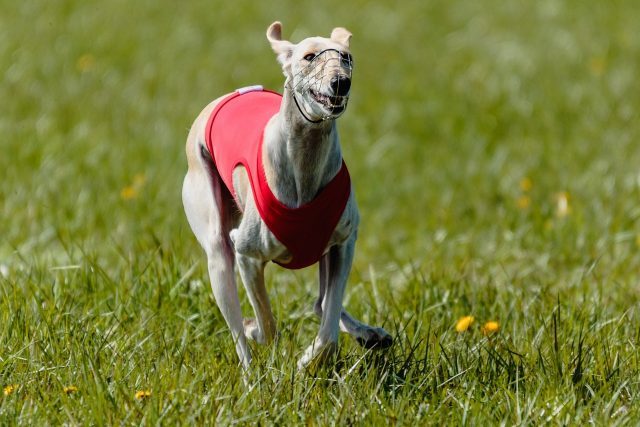Whippets are a breed of dog known for their grace, speed, and gentle nature. Often described as “miniature Greyhounds,” Whippets are elegant and athletic, with a history of racing and hunting small game. These medium-sized sighthounds are beloved for their affectionate and friendly demeanour, making them excellent companions for families and individuals. Despite their sleek appearance and calm disposition, Whippets exhibit unique behaviours that might seem unusual to those unfamiliar with the breed. These behaviours are perfectly normal for Whippets and are part of what makes them such endearing pets. Let’s explore seven crazy things perfectly normal for Whippets, shedding light on what makes this breed special.
1. The Zoomies
One of Whippets’ most entertaining and common behaviours is the “zoomies,” or sudden bursts of energy where they run around at breakneck speeds, often in circles or figure eights. This behaviour, also known as “frapping” (frenetic random activity periods), is a normal and healthy way for Whippets to release pent-up energy. Despite their calm and laid-back demeanour, Whippets are usually incredibly fast and agile when they get the zoomies, showcasing their natural speed and athleticism. This burst of energy is often followed by a period of relaxation, as Whippets love to lounge and rest. Providing them with space to run and play can help positively channel this energy.
2. Burrowing and Nesting
Whippets have a strong instinct to burrow and nest, often seeking cosy spots to curl up and feel secure. This behaviour is normal and stems from their need for warmth and comfort. Whippets have thin coats and very little body fat, making them sensitive to cold temperatures. They often burrow under blankets, pillows, or even in piles of laundry to create a warm, snug environment. Providing them with soft bedding and blankets can help satisfy their nesting instinct and comfort them. This behaviour highlights their need for a cosy and secure resting place, reflecting their affectionate and home-loving nature.
3. Velcro Dog Syndrome
Often referred to as “velcro dogs,” Whippets have a strong attachment to their owners and prefer always to stay close to them. This clingy behaviour is a normal part of their affectionate and loyal personality. Whippets thrive on human companionship and can become anxious or distressed when left alone for long periods. They enjoy following their owners from room to room, sitting on their laps, and even sleeping in the same bed if allowed. This close bond is one of the reasons why Whippets make such wonderful companions. Providing them with plenty of attention and reassurance can help keep them happy and secure.
4. Chasing and Prey Drive
Whippets have a strong prey drive, a trait inherited from their history as hunting and racing dogs. They are sighthounds, hunting primarily by sight rather than scent. This strong prey drive can manifest in a desire to chase moving objects like squirrels, rabbits, and even small pets. While this behaviour is perfectly normal, it requires management and training to ensure safety. Keeping Whippets on a leash during walks and providing a secure, fenced area to run and play can help prevent them from chasing after wildlife. Engaging them in controlled activities like lure coursing can also help satisfy their natural chasing instinct in a safe and structured way.
5. Trembling and Shivering
It’s not uncommon to see Whippets trembling or shivering, even when they are not cold. This behaviour can be surprising, but it is normal for the breed. Whippets have a sensitive and excitable nature, and trembling can be a response to various stimuli, including excitement, stress, or even anticipation. Their thin skin and lack of body fat also make them more prone to feeling cold, so shivering can sometimes indicate they need extra warmth. Providing a comfortable and warm environment and understanding their emotional triggers can help manage this behaviour. It’s important to recognize that trembling is a normal part of their physiological and emotional response.
6. Whippet Sphinx Pose
Whippets are known for their unique resting posture, often called the “Whippet Sphinx Pose.” In this position, they lay on their belly with their front legs extended forward, and their back legs stretched out behind them. This pose not only looks elegant but is also a comfortable resting position for Whippets. It reflects their flexible and agile nature, allowing them to rest while remaining alert and ready to act. The Sphinx Pose is a normal and healthy behaviour for Whippets, showcasing their unique blend of relaxation and readiness. Observing them in this pose is a reminder of their graceful and poised nature.
7. Selective Hearing and Independent Streak
Whippets are known for their intelligence and independent streak, which can sometimes translate into selective hearing. While they are generally eager to please, Whippets can be stubborn and may choose to ignore commands if they are distracted or uninterested. This behaviour is perfectly normal and reflects their independent nature. Training a Whippet requires patience, consistency, and positive reinforcement. Understanding their motivations and working with their natural instincts can help achieve better training outcomes. This selective hearing is not a sign of disobedience but an expression of their independent and intelligent personality.

Whippets are a breed full of unique behaviours and endearing quirks that make them delightful companions. Their zoomies, burrowing habits, velcro dog syndrome, strong prey drive, trembling, Sphinx Pose, and selective hearing set them apart from other breeds. Understanding and embracing these behaviours can help owners build a strong bond with their Whippet, ensuring a harmonious and fulfilling relationship. Their distinctive traits and lovable personalities make Whippets a truly special breed, offering companionship and loyalty that is both unique and rewarding.
